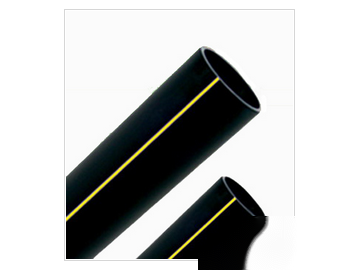
● Resistant to natural gas, liquefied gas, artificial coal gas, and other chemical corrosion, no secondary anti-corrosion required;
● Lightweight, high strength, and strong wear resistance;
● Beautiful appearance, smooth inner and outer walls, low fluid resistance, and soft colors;
● Uses socket fusion welding and electro-fusion welding, simple installation, good gas tightness, safe and reliable;
● Long service life, pipeline system exceeds 50 years under normal usage, low depreciation;
● Pipes can be coiled, easy to transport, low engineering costs;
● Good flexibility, earthquake resistance, and excellent impact resistance;
● Waste materials are recyclable and do not pollute the environment.

Polyethylene pipe connections generally use electro-fusion connections and hot-melt butt welding. When connecting polyethylene pipes to metal pipes, steel-plastic transition joints or flange connections are used.
1. Electro-fusion connection: Suitable for connecting pipes and electro-fusion fittings, the steps are as follows:
① Cut the pipe with a rotary cutter to make the cross-section perpendicular to the axis, mark the insertion depth, and scrape the PE oxide layer on the surface with a rotary scraper.
② Wipe the dirt on the connection surface of the pipe and fittings with a clean cotton cloth.
③ When connecting, align the corresponding connecting parts to be on the same axis and insert the pipe into the fitting socket.
④ Use the electro-fusion welding machine to heat according to its specified time, so that a uniform flange is formed at the connection.
2. Hot-melt butt welding:
① Fix the two pipes on the welding machine fixture, use a milling cutter to mill the ends and adjust to keep the central axis aligned.
② Adjust the heating time according to the pipe diameter and ambient temperature, and heat the ends of the two pipes with a heating plate.
③ After heating, remove the heating plate, quickly butt the pipes together according to the pre-adjusted pressure, and let cool to finish.
3. Steel-plastic transition joint connection:
① First, connect the PE end of the steel-plastic transition fitting to the PE pipe.
② Connect the steel end of the steel-plastic transition fitting to the metal pipe using threads, flanges, or welding methods.

| No. | Item | Performance Requirements | Testing Standard | |
| 1 | Long-term static hydraulic strength, Mpa (20℃, 50 years, 95%) | ≥8.0 | GB15558.1-2003 | |
| 2 | Short-term static hydraulic strength Mpa | 20℃ | Toughness failure time 9.0 (h) ≥100 | |
| 80℃ | Brittle failure time 4.5 (h) ≥165 | |||
| Failure time 4.0 (h) ≥1000 | ||||
| 3 | Thermal stability (200℃), min | >20 | ||
| 4 | Resistance to stress cracking, h (80℃, 4MGpa) | ≥1000 | ||
| ≥170 | ||||
| 5 | Compression recovery (80℃, 4MGpa) | >170 | ||
| 6 | Longitudinal shrinkage rate (110℃), % | ≤3 | ||
| 7 | Elongation at break % | ≥350 | ||
| 8 | Weather resistance (after the pipe material accumulates ≥3.5KMJ/㎡ aging energy) | Still meets the performance requirements of 2.3.7 and maintains good welding performance | ||
|
Note: Suitable for natural gas, artificial coal gas, and liquefied petroleum gas with a working temperature of -20℃ to 40℃ and a working pressure of ≤0.4Mpa. |
||||













